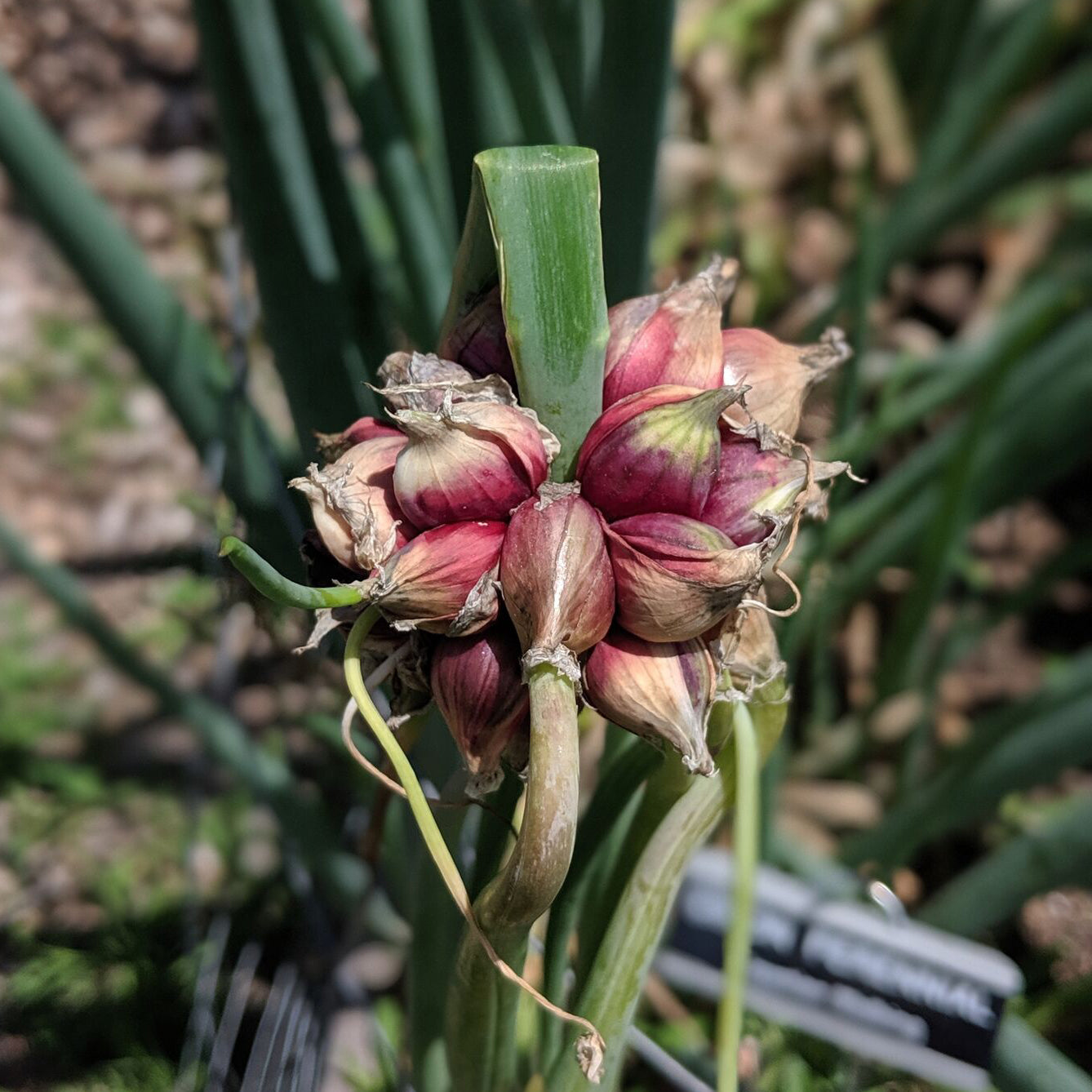When you think of onions perhaps a giant pyramid of yellow, white, or purple bulbs stacked up in the produce aisle comes to mind. As gardeners, we often grow these bi-annual bulb onions as annual vegetables, harvesting them after their first year of growth for their bulbs rather than letting them flower and go to seed. But did you know there are other types of onions that are delicious and easy to grow and come back every year? Perennial onions are a great way to increase your food-growing capacity and reduce your garden workload. They are also decorative and add interesting structural elements to your garden.
Many gardeners have found them to be an invaluable part of their decorative and culinary plans. For our purposes, the term “perennial” means that you don’t have to replant them each year because the original plant either survives the winter or is self-multiplying. Perennial onions are delightful for many reasons but especially because they are prolific and allow you to bring fresh onion flavor to your cooking year-round.
There are several different types of perennial onions, some that are more bulbous and others that can be used more like green scallions or leeks. Different types bring different flavors, textures, and users, all work well in either your annual vegetable beds or as part of a perennial vegetable bed, flower border, or in containers, cold frames, or greenhouses.
Egyptian Walking Onions
Egyptian Walking Onions are perhaps the most well-known of all the perennial onions. They get their name from the way they “walk” across the garden. They have a bulb about the size of a shallot in the ground with a tall green stalk coming out. At the top of the stalk a cluster of smaller bulbs form. Eventually, these bulbs become heavy and bend the stalk to the ground where they plant themselves a foot or two away from the original bulb. Though their history is a bit murky, Egyptian Walking Onions are thought to have originated in India or Pakistan and traveled to Egypt from there.
All parts of the Egyptian Walking Onion are edible. For the most onion-like experience pull up a clump of the larger bulbs from the ground, leaving a few in place, and use them like you would any other onion. The stalk or leaves can be used just like a scallion. You can also harvest the small top bulbs for an intense onion flavor burst in your cooking. These are particularly delicious roasted whole. They are delicious in soups and stews and are perfect for veggie soup broth which can be frozen and used for winter cooking.
Egyptian Walking Onions can be used to help protect fruit trees from root damage by voles who like to chew on the sweet roots of apple and pear trees. Voles are repelled by the smell of onions. You can harvest some of the larger onions and replant the remaining ones to give them more room to develop. Egyptian Walking Onions are one of the first things to come back in the spring and when they put up their top cluster of bulbs the shapes can be delightful. For full details on growing Egyptian Walking Onions check out our Growing Guide.

Potato Onions
Potato Onions are another type of perennial onion similar to Egyptian Walking Onions in their growth habit and use. They are not related to potatoes in any way. They were named for the fact that, like potatoes, growers will eat the larger ones and save the small ones to replant as “seeds”. Unlike Egyptian Walking Onions, they don’t grow the top bulb cluster and their bulbs tend to be larger and multiply faster. Their flavor is mild, similar to a sweet onion with some garlic tones to them. Being part of the allium family they have all the same uses and benefits as garlic, leeks, and regular bulbing onions. Some growers choose to harvest all of their Potato Onions in the fall and replant the smallest ones in the spring rather than leaving them in the ground year-round. For the Asheville area, either technique will work. Potato Onions store well in a cool, low-humidity setting. They should not be kept in the refrigerator. Potato Onions are a lower maintenance replacement for growing larger bulb onions as they multiply prolifically and can be left in the ground year-round. Growing Guide

Shallots
Shallots are also considered perennial onions because they are self-multiplying, allowing growers to separate and replant some of them after harvesting. Most people are familiar with shallots and their more delicate taste from grocery store offerings but if you’d like to learn how to grow them for yourself check out our Growing Guide. Like Egyptian Walking Onions they do not store well and it’s best to use them immediately after harvesting.

Ramps
Ramps are a spring ephemeral wild onion. They have grown in popularity over the last decade but they have been part of Appalachian culture for a long, long time. Ramps are a native plant that inhabits woodlands all over the eastern United States and parts of Canada. In the early spring, they put forth two small leaves attached to a delicate and pungent bulb. They grow in large clusters or patches, absorbing the early spring sunlight before the tree leaves fill in the canopy above them.
Ramps are a part of many native groups' traditional diets and were sustainably harvested for hundreds or even thousands of years before white settlers arrived. They have been part of Applachian cuisine for as long as people have lived here. Recently, their mystique has grown and they have become a delicacy served in high-end restaurants. This, plus their growing popularity with home cooks and habitat destruction has put a strain on wild ramp populations.
Growing ramps can be a little bit tricky since they need a shady woodland location and don’t like to compete with other ground covers. Their seeds can also take a while to germinate and it’s important to follow planting directions carefully. Check out our Growing Guide for more details.
When cooking with ramps keep in mind that they can have a strong taste, somewhere between garlic and onions. Ramps are delicious in an egg scramble, soup, stir fry, meat dishes and so much more. Anywhere you would use garlic or onions ramps can bring a depth of flavor rarely found in cultivated onions.


|
Article Written by: Leah Smith |
|
About the Author: Leah Smith is the Seed Product Manager at Sow True Seed, where she focuses on adding new varieties to the catalog and ensuring the seed stock is top-notch. Her firsthand experience in farming has given her a deep understanding of cultivating crops while caring for the environment. |



